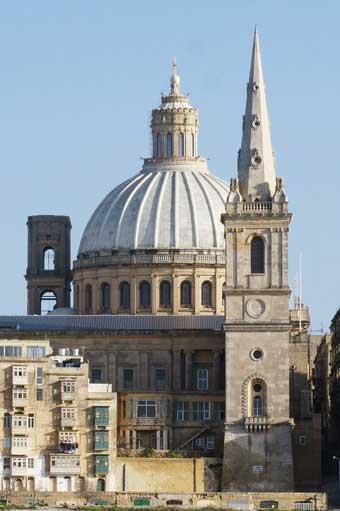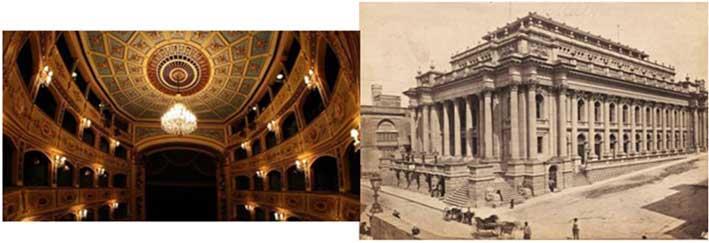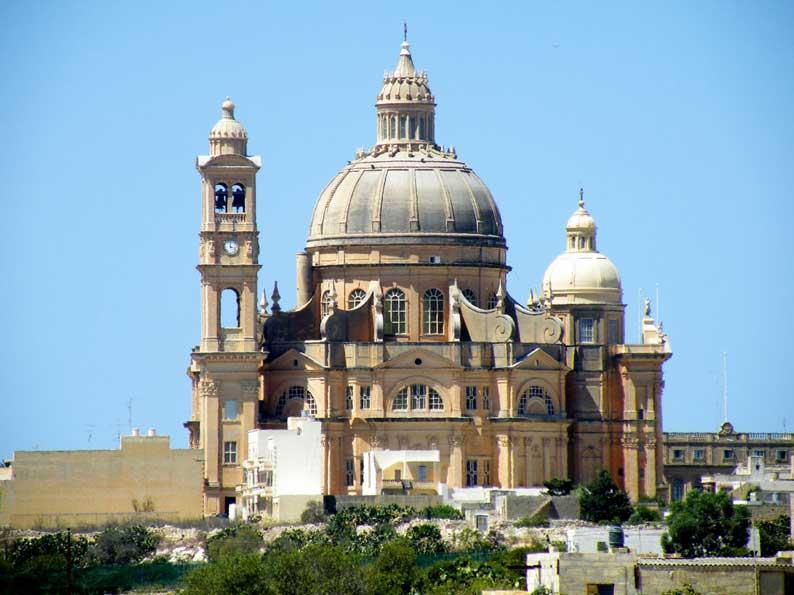Giuseppe Schembri Bonaci
Last week I discussed some important questions which have special significance when one studies how artistic styles and philosophies which were once dominant in certain historical periods cease to exist, yet in some strange and debatable manner continue to appear in other periods. They seemingly assume another life in an alien context.
This is why it is possible to find the Renaissance idiom in the 19th century. One may observe the return of the Gothic in the modern period. Scholars have developed specific expressions for these, examples of which include Neo-Gothic, Pseudo-Classical, and other terminologies which indicate the importance of such a question to the academic study of art. In other words, the debate focuses on how a dead idiom continues to find life in diverse periods, and what kind of living presence this idiom assumes after its death.

The direct confrontation between the Caremlite Church and the Anglican Church, Valletta
This argument makes better sense when one is reminded that a work of art is not created in isolation. It reflects a socio-economic and even political relationship. Within one work of art is the complex concentration of social relationships. The Classical, Renaissance, Mannerist, Baroque periods and all periods reflect and embrace specific social relationships. However, as we are fully aware, social, economic and political history is constantly evolving and changing, and at some moments is even altered radically. Therefore, if the Baroque of the 17th and 18th centuries is a concentration of social relationships corresponding to its time, how is it possible for it to inadvertently resurrect as a corpse in another time, for example in Modern times, having presently a radically different social relationship?
Such a rebirth of 'dead' art has long been discussed.

Monte Kristo Estates
Wölfflin questions the possibility of a person to perceive, interpret and appreciate works from the past and moreover recreate the birth of an artistic movement which is in fact dead.
How can a dead style be reborn? It is as if we desire to view reality with other eyes, those of the past. The extent to which one is able to see with eyes from the past is obviously debatable.
It is due to these reasons that I found Gavin Stamp's article on Maltese Baroque extremely intriguing. Stamp was taken aback with awe when he visited Malta and observed how Maltese Baroque is not only living, yet remains alive across a whole modern, modernist and post-modernist arena. The Xewkija Rotunda (Giuse Diacono/Guze d'Amato) defies any historical definition and reveals lacunae within the international study of architectural history. The existence of this church places serious doubts upon the modern interpretation of the progress of the history of art. In fact, according to Stamp, this work is proof of the incorrect methodologies used in artistic studies and research, and also the deficiencies in the definition of progress. Stamp considers the Xewkija Church to be a drastic challenge to the traditional idea of evolution in art.

The Manoel Theatre and the Royal Opera House, Valletta
Richard England responds in a parallel vein with the Manikata Church, a masterpiece of what I term as 'modern-primitivism'. In the contemporary period, England offered an intellectual and modern counter-point to the monumental and mediocre kitsch which the Monte Kristo Estate embodies. It is very interesting how these projects are practically contemporary and are conveying the problem of style and how different styles infiltrate into culture in a mysterious, yet even violent, manner. Other examples which demand further study are the aborted experiment of Frank Portelli and Emvin Cremona in the Gozitan theatres; the Aurora and the Astra. Portelli experimented with eclectic cubism whilst Cremona pursued a decorative Baroque, yet the two tried to assert the Baroque idiom, in a paradoxical way.
In its origins, the Baroque was built upon theological and religious principles. The exultance, the exuberance, the magnificence, the dichotomy between reality of here and the more real reality of 'there-from-here', the explosive theatricality, the illusion of transparency, the illusion of eternity, the illusion of speed and movement, the multi-perceptual, are all points which are fundamentally Baroque which were expressions integrated with spiritual belief and with an ideology of thought pertaining to a particular period. Today we have inherited these categories without, however, their spiritual-philosophical basis, which has led us to pure mediocrity and pantomime. This is occurring today with modern Maltese Baroque.

Xewkija Rotunda, Gozo
All artistic movements have their own political viewpoint. So does Maltese Baroque. The occupation of space and territory by an artistic idiom is part of its political efforts for power. The destruction of the Auberge d'Allemagne with the intention to construct the Anglican temple on its ruins, and the consequent confrontation by the Maltese Baroque of the Carmelite Church is an explicit example. Within this 50 metre distance is a fervent fight for economic, social and political power.
The Anglo-Saxon Royal Opera House with its Classical idiom as a direct challenge to the Baroque Manoel Theatre is another example of how the occupation of style with another, even opposing, idiom becomes a socio-political confrontation. It is no coincidence that the Royal Opera House suffered collapse during the ruinous fight between Italianate Malta and modern Malta.
Neither is it a coincidence that the Maltese state prolonged and is still contemplating the political, social and economic expression of this space. Nor is it strange that an Italian architect was chosen to create a modernist idiom on this very site.
And another example which deserves greater study is a more recent work. I am referring to the Memorial to the Second World War, created by a friend of mine Michael Sandle. The memorial once again gives birth to a Classical Anglo-Saxon idiom amongst the feudal-bourgeois bastions, a space defined by the Bourgeois-Baroque development throughout the past centuries.
The domination of space is the domination of power. The form of domination depends on the form of power. Maltese Baroque endlessly continued its struggle against the intervention of other idioms since their introduction denotes the loss of the monopoly of space, and hence the loss of power.
The Catholic Church here offered a solid platform for its artistic politics to serve as a buffer against the radical changes which were occurring in Malta throughout the previous century. The Baroque functioned as a phenomenal weapon.
And today? Today the Baroque has become a mediocre imitative copy which displays the total disintegration of the structures of power. Gregory Bateson refers to this situation as one of schismogenesis, meaning that a society is undergoing great change yet its fragments, in some mode or other, persist in their domination. Greenberg calls it kitsch. Deleuze refers to it as 'vulgarity and ignorance', T.J. Clark 'monstrosity'.
Article edited and translated by Nikki Petroni